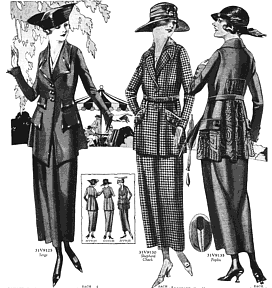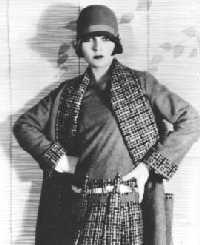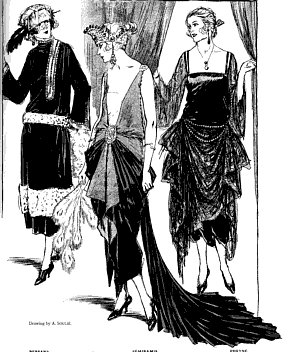Introduction
Fashion has long been accepted as either a form of expression or establishment of social status. People wear clothes in order to belong to a class as it was earlier indicated that those who are moneyed have the means to pay for stylists or designers for newer looks.
This paper will try to describe the 1920s fashion, from a 2008 perspective when there is a graying of borderline between high fashion, classic, chic, to cheap much dependent on retailers, but with the participation of manufacturers, marketing forces and consumers.
Discussion
The 1920s
It was said that the evolution of women in the workplace influenced a great deal on early 1920s fashion until the 1930s. The era has been noted for the evolving roles of women, from their right to vote, the First World War, the flapper era, and the rise of the media culture including the film industry (Clemente, 2006). On one end, France fashion in the 1920s included short hair, the bob was born, said to have been inspired by Jeanne d’ Arc or more known as Joan of Arc. It was also said that created an uproar, specifically from the opposite sex (Roberts, 1993). Changes in fashion, however, were seen at the turn of the century where “every aspect of female dress had not only changed but become the mirror opposite of what it had been…” (Roberts, 1993, p 658).
From the curvaceous and ideally voluptuous came the sinuous, smooth, and compressed lines as pioneered by Paul Poiret, new minimalist of the elite haute couture. Gabrielle Coco Chanel also from the period introduced her sporty, casual design further simplifying Poiret’s. It was also said that in 1916, Chanel had her hair cut into the rebellious bob so that by 1922, the hair together with the clothing styles were associated with young, independent garconne, or femme moderne and sexy.
Women Fashion
To describe some clothing fashion that emerged in the 1920s are some work-place clothes identical to men coat paired with pleated skirt slightly above the ankle (Appendix A) that dominate day wear. Another style emerged circa 1924 called the Basque dress with short sleeve, chequered or plain cotton with long torso and flowing skirt that flies above the ankles. By the following year, the 1 hour Dress emerged which is a slight modification of the Basque dress with leaner skirt cut, almost shapeless or same in dimension from the shoulders, to the waist down to the skirt which is slightly below the knee. It is accented with simple collar or a straight shawl or ribbon that almost run the length of the dress itself.
The evening wear, although still flowing and using smooth lines and clothing, are lavishly accented, if not layered and accessorized with elaborate hats (Appendix B). Other varieties include Greek inspired flowing clothes with slightly higher hemline than its earlier versions. Other popularized style in the era include sporty wear such as the cardigan, paired with shirt and knee-length skirt made of stretchable smooth fabric paired with rubber shoes and high sporty socks.
As mentioned above, fashion even in this period is indicative of social stratification; that clothing is both a self-expression and a social identity that is experienced, communicated and reproduced (Barnard, 2002). These changes in fashion documented the role, status and perception of women not only in France but also in the United States and the American society. This is also reflected in their attitude, behavior, as well as the dress purposes as seen of women workers in 1920s America who wore eclectic mix of overalls, men’s caps, silk stockings and fire-engine-red lipsticks while on strike in the 1929 southern textile mills strike (Clemente, 2006). This was in contrast to a 1909 Shirtwaist Strike in New York City characterized by women in feathered hats, fur muffs, and French heels.
In both American and French instances, there is a form of gender expression, a breaking out from the norm as the weaker sex or the oppressed counterpart of males. Clothing became symbolical in the search for group identity, recognition and power as they created a “hybridized” (Clemente, 2006, p 3) visual representation as females and employees. Other characteristics of women fashion in the 1920s include the regular changes in skirt length. It sometimes gets long and sometimes shorter. Styles include dipping, scalloped, and handkerchief hemlines using floating fabrics. By 1925, skirts have risen to about 14 to 16 inches or 45-50 cm from the ground, meaning, shorter hemlines (Thomas, 2008).
The flapper age is mostly associated to 1920s fashion when women accepted modernism per se. The total image had the woman with shorter than previous as well as shapeless shift dress, flat chest, applied and wore make-up in public, danced the jazz at nights, as well as smoked with long cigarette holder showing a rebellious side. Aside from the more affordable clothing with simpler cuts and styles, of Butterick dress patterns that can be made at home.
Cloche Hats
Another characteristic of the 20s is the use of cloche hats that indicate short hair, and the “roaring twenties.” The hat is characterized by bell shape contour and if done properly, could even add height to the wearer as that of a military hat, pulled down over the eyes to make the wearer lift his head and peer through, creating the snooty look.
The 1920s also influenced a wider, or global reach as inspirations came from other countries outside the west: Egypt, China, Japan or Russia where designers reinvented the tiara, the turbans, kokoshiks and toques. Retailers included an atelier, as well as accessories where clothes buyers may also select hats and even perfume to match their preferred clothes.
Sophistication came with the donning of short hair and cloche hats as make-up also became the trend as application of make-up from glamorous compact symbolized womanly grace and refinement defining the face in modern style as long flowing hair is abandoned (Thomas, 2008).
The Cloche Hat has evolved from that “close fitting hats with deep crowns that clung over the brow had emerged and as the war years progressed. At both the start and end of World War 1 the close head fit became even snugger,” (Thomas, 2008) to cloche hats with small brims at the front and then reduced brim size, and to a disappeared brim or asymmetric brims.
Men Fashion
As women of the 1920s abandoned restricting forms, men also adopted comfortable clothes as they veer away from overly formal ones. Sporty clothes were preferred and it is even considered that the 1920s style for men are still used until today. Two distinct periods were seen in menswear who wore short suit jackets as the long jackets were preferred for formal occasions. The early twenties also showed extremely high-waisted jackets. Belt was common while it is also usual to have slimmer lapels on suit jackets that are buttoned up high. This is said to have been influenced by military uniforms used in the previous war. The pants or trousers were straight, slimmer, narrow and shorter that when the wearer sits down, the socks showed. The trousers were also cuffed at the bottom. Oxford bags came into fashion in 1925 characterized by wider trousers. The suit jackets have once again adopted the wider lapel and normal waist as loose sleeves were introduced. The double-breasted vest usually worn with a single breasted jacket was also the trend as sport clothes grew in variety. Sweaters, short trousers called knickers were considered fashionable and sporty (Appendix D). Evening suits are short tuxedo (Wikipedia, 2008).
Conclusion
The 1920s fashion focused on women’s physical looks that include hair, clothes, accessories and shoes. This is a period that denotes social changes where there is a clamour for shift of power from male centered one to equal distribution of freedom and power for both sexes.
The simplicity of the cut and flowing features of the clothes indicate the need to be agile and flexible. The mimicry of male clothing and shortened hair cuts also showed the women’s desire to be on the same level with the opposite sex, if not on equal footing. But the retention of elaborate design and layering showed mystery and retention of women’s preference for exquisite and lavish pampering which may spell towards her continuing romantic relations with the opposite sex.
Overall, fashion in the 1920s indicate the continuing changes in the experiences and needs of women evolving from its earlier period towards an ideal one or a form of rebellion to one tarnished fashionable era towards a new adventure brought about by changes always accompanied by fashion trends.
For the men, the trend towards comfort was also inevitable as differentiation between sporty, daytime and formal occasion wear are pronounced yet easily accessible and affordable. While there is no political inclination for men’s fashion, economy and personal comfort were the basic influences that dictated trend.
References
Adore Vintage / Starzinsky (2005). Fashion & Style » The 1920’s-1930′. “20’s Fashion”
Clemente, Deirdre (2006). “Striking Ensembles: The Importance of Clothing on the Picket Line.” Labor Studies Journal, Volume 30, Number 4, 2006, pp. 1-15
Roberts, Mary Louise (1993). “Samson and Delilah Revisited: The Politics of Women’s Fashion in 1920s France.” The American Historical Review, Vol. 98, No. 3 (1993), pp. 657-684
Thomas, Pauline Weston (2008). “Flapper Fashion 1920s. C20th Fashion History.” Fashion Era.
Wikipedia. (2008). “1920s in Fashion.”
Appendix




